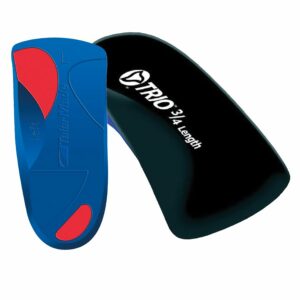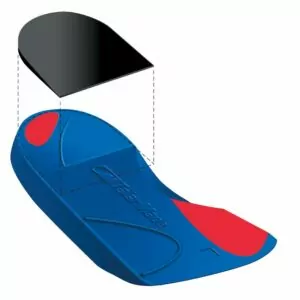Diagnostic Guide – Lower Leg Pain
Updated:
Patients suffering from lower leg pain are frequently seen in physiotherapy practice, particularly in athletes or those involved in sports participation. Pain may be caused by local structures within the calf or shin, or, may be referred from other sources (such as the lower back, knee or ankle).
Sudden onset calf pain often occurs in athletes or individuals involved in fast moving change-of-direction sports and those sports which involve rapid acceleration and deceleration (such as squash, tennis, football, soccer and basketball). The most common cause of sudden onset calf pain is a Calf Strain (Gastrocnemius) (figure 1) whilst the most likely cause of sudden onset shin pain is a shin contusion typically occurring due to a collision with a hard object such as a football boot.

Gradual onset lower leg pain often occurs in those patients involved in sports or activities that involve high running loads often in combination with poor foot biomechanics. One of the most common causes of this exercise related gradual onset shin pain is Shin Splints.
There are numerous other causes of lower leg pain, some of which present suddenly due to a specific incident, others which develop gradually over time. Calf pain originating from serious conditions, such as a DVT (deep vein thrombosis) is a possibility (particularly in patients with swelling, colour change of the affected leg, foot or ankle, or warmth over the affected area) and if suspected, must be immediately ruled out by a doctor (particularly when risk factors, such as recent travel, oral contraception use or recent surgery, are present).
Below are some of the more common causes of lower leg pain with a brief description of each condition to aid diagnosis. Conditions have been organised according to sudden or gradual onset and common or less common conditions for ease of use.
Find out what may be causing your lower leg pain:
Sudden Onset Lower Leg Pain – Common Conditions
Calf Strain (Gastrocnemius)
Tearing of the calf muscle (gastrocnemius – figure 1), typically following a sudden acceleration movement. Associated with localised pain in the back of the lower leg, pain on firmly touching the affected region and often pain on performing a heel raise (i.e. lifting the heels off the ground – figure 2) and on performing a calf stretch (figure 3).
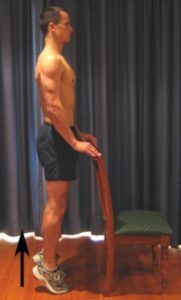

Calf Strain (Soleus)
Tearing of the deeper calf muscle (soleus – figure 1), typically following a sudden acceleration movement. Associated with localised pain in the back of the lower leg, pain on firmly touching the affected region and often pain on performing a heel raise (i.e. lifting the heels off the ground – figure 2) and on performing a soleus stretch (figure 4).
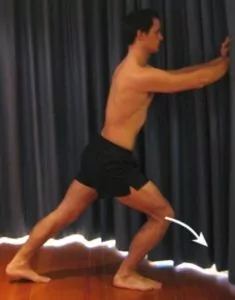
Shin Contusion
Bruising of the shin bone (tibia – figure 5) following a direct impact from a hard object such as a football boot. Typically associated with pain on firmly touching the affected region, an increased bony prominence corresponding with the point of impact and sometimes visible bruising and swelling which may present directly after injury, or, some days later.

Calf Contusion
Bruising of the calf (figure 1) following a direct impact from a hard object such as a football boot. Typically associated with pain on firmly touching the affected region and sometimes visible bruising which may present some days following injury. Pain may increase on performing a heel raise (figure 2) or calf stretch (figure 3).
Calf Cramp
A painful, involuntary contraction of the calf muscle that can occur suddenly and may prevent the individual from continuing activity. Occasionally these can happen at night time and typically cause a feeling of tightness in the calf that usually eases upon gently performing a calf stretch (figure 3)
Less Common Sudden Onset Conditions
Referred Pain
Pain referred to the lower leg from another source such as the lower back or knee, often associated with symptoms above or below the lower leg (such as lower back pain or stiffness or pain in the groin, thigh, knee, ankle or foot). Typically associated with pain on firmly touching the region responsible for the referred pain and / or loss of movement in that region. Sometimes in association with pins and needles or numbness in the affected leg or foot.
Tibial Fracture
A break in the shin bone (tibia – figure 5), which may occur in association with a rolled ankle, due to a fall from a height or following a forceful impact to the front of the shin. Pain is usually severe and often results in an inability to weight-bear. There may be visible deformity of the shin bone and often significant swelling. Pain typically increases on firmly touching the affected region of the bone and occasionally pins and needles or numbness may be present in the lower leg, ankle or foot.
Fibular Fracture
A break in the outer lower leg bone (fibula – figure 6), which often occurs in association with a rolled ankle or due to a fall from a height or forceful impact to the outer aspect of the lower leg. Pain is usually severe and typically increases on firmly touching the affected region of the bone. In some cases, there may be visible deformity of the bone and often significant swelling. Occasionally pins and needles or numbness may be present in the lower leg, ankle or foot.
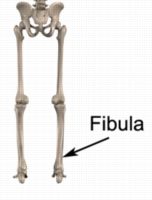
Gradual Onset Lower Leg Pain – Common Conditions

Members Only ContentBecome a PhysioAdvisor Member to gain full access to this exclusive content. For more details see Become a Member. Already a member? Login Now
Less Common Gradual Onset Conditions

Members Only ContentBecome a PhysioAdvisor Member to gain full access to this exclusive content. For more details see Become a Member. Already a member? Login Now
Diagnosis of lower leg pain
A thorough subjective and objective examination from a physiotherapist is usually sufficient to diagnose the cause of lower leg pain. Investigations such as an X-ray, ultrasound, MRI, CT scan, bone scan or compartment pressure testing are often required to confirm diagnosis and rule out other injuries.
Find a Physio
Find a physiotherapist in your local area who can diagnose and treat patients suffering from lower leg pain.
More Information
- View more Calf Strengthening Exercises.
- View more Calf Flexibility Exercises.
- View Ankle Stretches.
- View Balance Exercises.
- View Massage Ball Exercises designed to improve lower body flexibility.
- View Foam Roller Exercises designed to improve lower body flexibility
- View detailed information on How to use Crutches.
- View detailed information on when to use Ice or Heat.
- View detailed information on Choosing a Shoe.
- View detailed information on Do I Need Orthotics?
- View detailed information on initial injury management and the R.I.C.E Regime.
- View a Return to Running Program.
Physiotherapy products for lower leg pain
Some of the most commonly recommended products by physiotherapist for patients with lower leg injuries include:
To purchase physiotherapy products to assist with rehabilitation click on one of the above links or visit the PhysioAdvisor Shop.

Link to this Page
If you would like to link to this article on your website, simply copy the code below and add it to your page:
<a href="https://physioadvisor.com.au/injuries/lower-leg”>Diagnostic Guide – Lower Leg Pain – PhysioAdvisor.com</a><br/>PhysioAdvisor provides a diagnostic guide for patients suffering from calf pain, shin injuries and lower leg pain created by experienced physiotherapists.
Return to the top of Diagnostic Guide – Lower Leg Pain.

